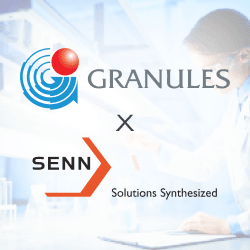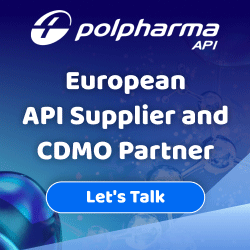Overview of API particle size reduction via micronization & contract milling services including bead milling & jet-milling offered by pharma CDMOs.
Q1. What is particle size reduction? Why is particle size important in the pharmaceutical industry?
Size reduction is a process of reducing large solid unit masses into small unit masses, coarse particles or fine particles. Size reduction is also called comminution, pulverizations and grinding. In pharmaceutical manufacturing, size reduction is one of the most extensively used and vital unit operations. Pharmaceutical size reduction is used primarily for the purposes of control of the dissolution rate and absorption, control of chemical reactions, control of physical characteristics. Generally this process is done by precipitation method or mechanical method.
New drug development is a long process in which many complicated steps are involved in the identification and development of an active pharmaceutical ingredient (API) into a suitable dosage form or drug product. In pharmaceutical research and development, various new chemical entities (NCE) are found to be poorly water-soluble due to which they are rejected during early stages. Solubility is strongly related to the bioavailability and release of the drug.
Almost all size-reduction techniques or API micronization techniques create new surface area to enhance the solubility and dissolution rate. In the pharmaceutical industry, particle size has become one of the key aspects in the development of the active pharmaceutical ingredients (APIs) and quality control of solid oral drug products. Therefore, particle size reduction plays a major role in designing different drug delivery systems, for example inhalers, sustained release (SR) formulations, etc. It is a fast and cost-effective answer to increasing the exposure of poorly soluble oral drugs by increasing surface area and thereby improving solubility and dissolution rate.
In a solid drug formulation, there are four intrinsic properties, including composition, particle size, particle shape and particle surface characteristics. Among other factors, particle size of API is the most important property which needs to be considered during the pharmaceutical development and manufacturing process.
Importance of Particle Size in Pharmaceutical Industry:
- Particle size is a crucial parameter in the pharmaceutical industry, because it influences surface area and porosity, and hence has an impact on bioavailability, effectiveness and shelf life of a drug.
- The particle size significantly affects particle shape, surface area, powder flowability, bulk density, hygroscopicity, compatibility, porosity and blend uniformity. This, in turn, can affect everything from bioavailability to stability.
- The particle size can affect the rate at which a substance will dissolve. Smaller particles have a smaller surface area, therefore making dissolution occur more quickly.
- Particle size is an important attribute in APIs, solid oral drug products, such as tablets, capsules and as a critical quality attribute in semi-solids and sterile liquid drug products, such as injectables.
- Particle shape, particle size distribution and particle surface characteristics also influence the performance, behavior and suitability of a drug formulation.
- Given the increasingly potent active pharmaceutical ingredients being developed, smaller particle sizes are typically more desirable in today’s pharmaceutical industry.
- The particle size distribution (PSD) control is also relevant for the manufacturer of the active pharmaceutical ingredients to determine the performance of crystalline material and the efficiency of production unit operations. The narrower the particle size distribution range, the more on-spec product manufactures.
There are various contract pharmaceutical organizations which may offer various particle size reduction contract services, including active pharmaceutical ingredient (API) micronization, jet milling, media milling of active pharmaceutical ingredients (API), which are performed in a GMP environment. Additionally, they can provide contract milling services for a range of substances from chemicals, minerals to micronized active drug substances (APIs). All the contract particle size reduction services can be followed by further blending with other pharmaceutical additives (dry or liquid) depending upon the requirement and followed by packaging to suit individual requirements.
Q2. What are the different techniques for particle size reduction of APIs?
Many particle size measurements are made to track size reduction operations such as micronization, milling, mixing, homogenization, etc. The choice of API particle size analysis technique can be based on the size distribution.
Micronization
Micronization is the process of reducing a bulk solid material’s particle size to the micron or submicron level. Particle size reduction during the micronization occurs without any intervention by mechanical components, but using a pressurized process gas to impart high velocity to the particles to reduce agglomeration. Particle size reduction is finally the result of the particle collisions inside the micronization chamber.
Jet Milling
Until the introduction of jet mills, the process was long, expensive and inefficient to create fine particles with a narrow PSD. Any powder that is crystalline or friable can be ground in a jet mill. The minimum API particle size that can be obtained using a jet mill depends on the inner friability of the material. Many active pharmaceutical ingredients (APIs) or micronized active drug substances (APIs) are precipitated at the nanometer-scale and can cause agglomeration. Jet mill can deagglomerate these APIs down to their original nanometer base-particle size.
Jet milling uses pressurized gas to create high particle velocity and high-energy impact between particles. Jet mills are used for achieving particle size as small as 1-2 microns. Furthermore, they are the preferred method of micronizing an API particle for use in inhalation drug products. Fluidized jet mills allow for high impact velocities of 300-500 meters per second, compared to 50-150 meters per second. It allows greater control of the maximum particle size and reduces agglomeration between the particles.
Bead milling
Bead milling is widely used as an API micronization method for pharmaceuticals. A bead mill uses wet mechanical milling to obtain nanoscale particles as small as 200–400 nm, that is why it is referred to as nanonization or nano-milling. It follows an impact and shear mechanism to reduce the API particle size and because bead milling is a wet process, it avoids any problem related to dust while micronizing an API particle.
Ball Milling
Ball mills tend to be the least expensive active pharmaceutical ingredient (API) micronization option for enhancing drug solubility. Ball mill is an API micronization techniques which micronizes material by agitating it in a vessel using steel or ceramic balls or other media.
Wet Milling
Wet milling is used for continuous dispersion and fine wet grinding of solids in a liquid system which is capable of dispersion and wet grinding for fillers, paints, agricultural chemicals and pigments. Wet mill micronization is the ideal tool for controlled particle size reduction during API development and has many advantages over jet milling.
Vibration sieving
Milling and vibration sieving are also API micronization techniques commonly used for powder processing operations. The milling of active pharmaceutical ingredients (API) is mainly applied to a slight particle size reduction (above 10 microns).
The particle size reduction contract services can be easily outsourced to contract pharmaceutical service providers. They may have expertise and state-of-the-art manufacturing facilities to help in the production of homogeneous mixtures from solid components with different particle sizes or consistencies. They can provide the contract milling services or contract particle size reduction services for quantities of just a few kilos through to pilot scale quantities and then through to production scale as per the requirement.
Q3. What are the advantages of using micronization to reduce API particle size?
Micronization is one of the most commonly used methods for particle size reduction. The micronization process reduces the particle size of API to micrometer size, highly increasing the substance surface which can be used to improve the bioavailability of poorly soluble APIs by increasing particle surface area and accelerating dissolution rates.
There are a variety of API micronization techniques available to improve solubility of poorly soluble APIs; precise control over particle size of API (particle size of active pharmaceutical ingredients) has become all the rage. Whether administered orally or topically (semi-solid drugs), solubility is a key factor in determining bioavailability and ultimately the effectiveness of different types of drugs.
Poor bioavailability is often a result of poor solubility. Within the pharmaceutical industry, it is a widely accepted fact that the finer the particle size of API, the better the dissolution rate, which leads to faster absorption by the human body.
Advantages of Micronization are noted below:
- Micronization technique is especially dedicated for the heat-sensitive products, because the temperature remains relatively constant throughout the whole process.
- Micronization can also be used to improve formulation homogeneity and control particle size. The mixing of several solid ingredients is easier and more uniform if the ingredients are reduced to the same particle size.
- A wide range of drug types, including solid, injectable, ocular and inhaled drug products can benefit from using API micronization or micronized APIs.
- Micronization helps to attain finer particle size, which is required for pharmaceutical oral suspensions, to reduce the rate of sedimentation.
- Mechanical particle-size reduction and screening using micronization can also be used to obtain micrometer and nanometer-sized particles. It means that when a given volume of material is made up of smaller particles, the surface area of the material increases, which ultimately increases the solubility.
- Micronization technique is also commonly used to reduce the droplet size distribution of ophthalmic emulsions and solutions. All the ophthalmic preparations and other pharmaceutical formulations meant for external application on the skin, must be free from gritty particles to avoid irritation in the area on which they are applied, hence micronized ingredients are required.
- The rate of absorption of a drug depends on the dosage form, route of administration, particle size of active pharmaceutical ingredients (API) and other excipients used in the formulation. Micronized APIs offer solubility and bioavailability enhancement.
- The physical appearance of various semi-solid dosage forms, such as ointments, pastes and creams, can be improved by reducing its particle size.
There are a number of contract micronizing service providers offering micronized active drug substances (APIs) and particle size reduction contract services via various micronization techniques, such as bead milling, jet milling and nano-milling, to reduce particle size of active pharmaceutical ingredients (API) for solubility and dissolution enhancement. The contract milling services and other API and formulation services can be outsourced to the contract development and manufacturing organizations (CDMOs).
Q4. Which are the leading companies offering API particle size reduction contract services?
Various pharmaceutical organizations, such as a contract development and manufacturing organization (CDMO) and contract manufacturing organization (CMOs), can offer micronized APIs and contract particle size reduction services to reduce the particle size of active pharmaceutical ingredients (API) via contract milling services, such as bead milling, jet milling, wet milling and micronization, etc.
They may offer particle-size reduction and screening services as well as contract milling services for a range of substances from chemicals to APIs to achieve the desired particle size. Some of the top pharmaceutical companies offering API particle size reduction contract services and micronized APIs are mentioned below.
Minakem- Active Pharmaceutical Ingredient (API) Micronization Service Provider
Minakem is a contract micronizing service provider which offers various solid state services, such as particle size reduction and control, polymorph (solvate or hydrate), salt and cocrystal study, isomer separation, scalable crystallisation process development, filtration and drying study.
EUROAPI- Bioavailability Enhancement via Micronization
EUROAPIoffers bioavailability enhancement through particle engineering (micronization, spray drying). It covers both APIs sales and contract development and manufacturing.
Quotient Sciences- Micronized Formulation Development
Quotient provides various formulation services, solubility-enhanced dosage forms, such as micronized API in bottle, capsule or tablet formats, amorphous (spray-dried, HME) dispersion in a bottle, lipidic vehicles, such as self-emulsifying and microemulsifying drug delivery systems, etc.
Eurofins CDMO- Active Pharmaceutical Ingredient (API) Micronization
To support API solid form R&D programs, Eurofins apply high-throughput screening technology for discovery of new polymorphs, particle size engineering and development or automated crystallization scale-up development.
Hi-Tis- Particle-Size Reduction and Screening
Hi-Tis is a contract micronizing service provider which offers various solid treatments like micronization,particle size reduction contract services, grinding, compaction, granulation, etc. Their micronization process, cleaning procedures and analytical methods used for the determination of the particle size are validated according to ICH guidelines.
Catalent Pharma Solutions- Pharmaceutical Contract Micronization and Micronized APIs
Catalent Micron Technologies is a leading international provider of formulation services and contract particle size reduction services. They deliver first-class pharmaceutical contract micronization, milling of active pharmaceutical ingredients (API) and analytical services.
All Suppliers












 EUROAPI, the leading small molecules API player, provides both API sales & CDMO services.
EUROAPI, the leading small molecules API player, provides both API sales & CDMO services.












